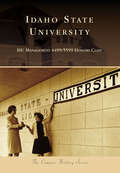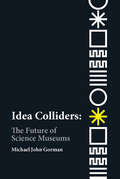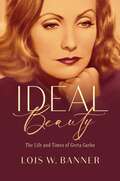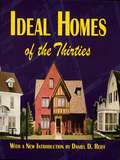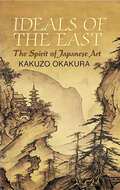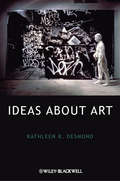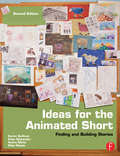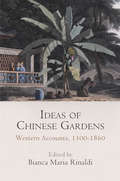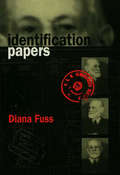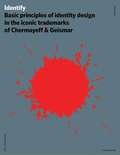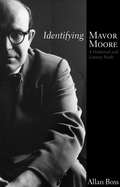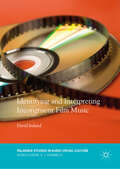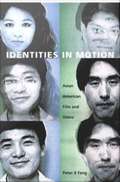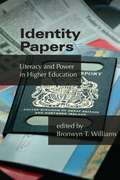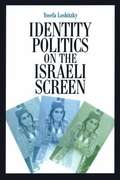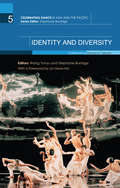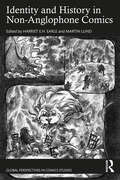- Table View
- List View
Idaho State University (Campus History)
by Isu Management ClassIdaho State University (ISU) opened in 1901 on 10 acres of land donated by the residents of Pocatello east of the Oregon Short Line Railroad tracks. From its humble beginnings as a school for vocational training with four faculty and fewer than 100 students, ISU has grown into a research institution serving over 12,000 students in undergraduate, master’s, and doctoral programs. The university has witnessed four name changes and weathered the adversity of two world wars and the ebb and flow of the economic fortunes of the Intermountain West. But Idaho State University has survived and thrived because of the efforts of its supporters, the commitment of its alumni, and the spirit of its students.
Idea Colliders: The Future of Science Museums (metaLAB Projects)
by Michael John GormanA provocative call for the transformation of science museums into "idea colliders" that spark creative collaborations and connections.Today's science museums descend from the Kunst-und Wunderkammern of the Renaissance--collectors' private cabinets of curiosities--through the Crystal Palace exhibition of 1851 to today's "interactive" exhibits promising educational fun. In this book, Michael John Gorman issues a provocative call for the transformation of science museums and science centers from institutions dedicated to the transmission of cultural capital to dynamic "idea colliders" that spark creative collaborations and connections. This new kind of science museum would not stage structured tableaux of science facts but would draw scientists into conversation with artists, designers, policymakers, and the public. Rather than insulating visitors from each other with apps and audio guides, the science museum would consider each visitor a resource, bringing questions, ideas, and experiences from a unique perspective.
IdeaSelling
by Sam HarrisonDon't let your creative ideas get picked apart and put down! If you're like most creative people, chances are high that you've had your share of ideas rejected by clients or decision makers. While we sometimes make the mistake of believing ideas should sell themselves, the fact is that the better and bolder the idea, the more it needs selling. This book contains powerful techniques to help you sell your ideas to those with approval power. You'll find tips from designers, writers, marketers and other creative professionals, along with meaty advice from selling and branding gurus. In no time, you'll be able to convince those who hold the purse strings that your ideas are worth pursuing and investing in. "Designers have a little known secret: Designing something is the easy part, getting others, specifically clients, to embrace that design is the real hard part. Harrison has put together dozens of tips that, if applied correctly, independently or in unison, will help you get those great design ideas approved." -Armin Vit and Bryony Gomez-Palacio, authors of Graphic Design, Referenced
IdeaSelling: Successfully Pitch Your Creative Ideas to Bosses, Clients & other Decision Makers
by Sam HarrisonDon't let your creative ideas get picked apart and put down!If you're like most creative people, chances are high that you've had your share of ideas rejected by clients or decision makers. While we sometimes make the mistake of believing ideas should sell themselves, the fact is that the better and bolder the idea, the more it needs selling. This book contains powerful techniques to help you sell your ideas to those with approval power. You'll find tips from designers, writers, marketers and other creative professionals, along with meaty advice from selling and branding gurus. In no time, you'll be able to convince those who hold the purse strings that your ideas are worth pursuing and investing in."Designers have a little known secret: Designing something is the easy part, getting others, specifically clients, to embrace that design is the real hard part. Harrison has put together dozens of tips that, if applied correctly, independently or in unison, will help you get those great design ideas approved."-Armin Vit and Bryony Gomez-Palacio, authors of Graphic Design, Referenced
Ideal Beauty: The Life and Times of Greta Garbo
by Lois W. BannerOne of the silver screen’s greatest beauties, Greta Garbo was also one of its most profound enigmas. A star in both silent pictures and talkies, Garbo kept viewers riveted with understated performances that suggested deep melancholy and strong desires roiling just under the surface. And offscreen, the intensely private Garbo was perhaps even more mysterious and alluring, as her retirement from Hollywood at age thirty-six only fueled the public’s fascination. Ideal Beauty reveals the woman behind the mystique, a woman who overcame an impoverished childhood to become a student at the Swedish Royal Dramatic Academy, an actress in European films, and ultimately a Hollywood star. Chronicling her tough negotiations with Louis B. Mayer at MGM, it shows how Garbo carved out enough power in Hollywood to craft a distinctly new feminist screen presence in films like Queen Christina. Banner draws on over ten years of in-depth archival research in Sweden, Germany, France, and the United States to demonstrate how, away from the camera’s glare, Garbo’s life was even more intriguing. Ideal Beauty takes a fresh look at an icon who helped to define female beauty in the twentieth century and provides answers to much-debated questions about Garbo’s childhood, sexuality, career, illnesses and breakdowns, and spiritual awakening.
Ideal Homes of the Thirties (Dover Architecture)
by Ideal Homes Daniel ReiffAdapted from a rare 1933 catalog, this volume showcases sixty plans for two-story houses. It features photographs (most in full color), floor plans, and descriptive text that depict a splendid variety of economic styles, including colonial, mission, foursquare, and bungalow. Each house appears in a two-page spread, forming an elegant and highly readable presentation.The Plan Service Company of St. Paul, Minnesota, published a series of Ideal Homes catalogs in the 1920s and '30s. This particular issue has been long out of print, and its reissue offers professional architects and armchair renovators alike an authentic look at houses of the era. Daniel D. Reiff, an expert on vintage house design catalogs, provides an informative introduction.
Ideals of the East: The Spirit of Japanese Art
by Kakuzo Okakura Sister NiveditaWritten by the foremost authority of the era on Oriental archeology and art, this extremely influential book offers a brief but concise introduction to Asian art. First published in 1883, it responded to a vogue in Western culture for a growing awareness and appreciation of Japanese artistic expressions of beauty and philosophy -- a perspective that remains fresh and valid.Author Kakuzo Okakura (1862-1913) was a co-founder of the Tokyo Fine Art School (now known as Tokyo National University of Fine Arts and Music) and a curator of Oriental art at Boston's Museum of Fine Arts. He also wrote The Book of Tea, and together with this volume, his writings rank among the most widely read English-language works about Japan. Ideals of the East wrought profound effects on the Western understanding of the internal consistencies and strengths of East Asian aesthetic traditions. One of its major themes, the connections between spirituality and the evolution of Asian art, provided English-speaking people with the earliest lucid account of Zen Buddhism and its relation to the arts.
Ideas About Art
by Kathleen K. DesmondIdeas About Art is an intelligent, accessible introductory text for students interested in learning how to think about aesthetics. It uses stories drawn from the experiences of individuals involved in the arts as a means of exposing readers to the philosophies, theories, and arguments that shape and drive visual art. An accessible, story-driven introduction to aesthetic theory and philosophy Prompts readers to develop independent ideas about aesthetics; this is a guide on how to think, not what to think Includes discussions of non-western, contemporary, and discipline-specific theories Examines a range of art-based dilemmas across a wide variety of disciplines - from art and design and law to visual and museum studies
Ideas Para Piscinas: Diecisiete capítulos sobre cómo crear, mantener y usar de forma segura una piscina de jardín.
by Owen JonesHola y gracias por comprar mi libro electrónico llamado ‘Ideas Para Piscinas'. Espero que encuentre aquí información útil, práctica y posiblemente rentable en el futuro. La información en este libro electrónico sobre cómo aprovechar al máximo las ideas que pueda tener sobre piscinas hogareñas está organizada en 17 capítulos de aproximadamente 500 a 600 palabras cada uno. Espero que les interese a quienes quieran comenzar a construir o aprovechar al máximo una piscina hogareña. También será útil para aquellos que podrían estar pensando en iniciarse en el negocio de construir o cuidar piscinas. Sin embargo, es una guía para principiantes, aunque con la esperanza de que sea lo suficientemente interesante como para comenzar. Como un bono adicional, le concedo permiso para usar el contenido en su propio sitio web o en sus propios blogs y boletines, aunque es mejor si los vuelve a escribir con sus propias palabras. También puede dividir el libro y revender los artículos. De hecho, el único derecho que no tiene es revender o regalar el libro tal como se le entregó.
Ideas That Shaped Buildings
by Fil HearnIn Ideas That Shaped Buildings, Fil Hearn identifies and codifies into theoretical systems the operative tenets of architectural theory from ancient Rome to the present.
Ideas for the Animated Short: Finding and Building Stories
by Karen Sullivan Gary SchumerFollow from start to finish the creation of an animated short from the pre-production thought process to story development and character design. Explore the best practices and avoid the common pitfalls of creating two to five minute shorts. Watch a specially created animated short, demonstrating the core techniques and principles at the companion website! Packed with illustrated examples of idea generation, character and story development, acting, dialogue and storyboarding practice this is your conceptual toolkit proven to meet the challenges of this unique art form. The companion website includes in-depth interviews with industry insiders, 18 short animations (many with accompanying animatics, character designs and environment designs) and an acting workshop to get your animated short off to a flying start! With all NEW content on script writing, acting, sound design and visual storytelling as well as stereoscopic 3D storytelling, further enhance your animated shorts and apply the industry best practices to your own projects and workflows.
Ideas of Chinese Gardens: Western Accounts, 1300-1860 (Penn Studies in Landscape Architecture)
by Bianca Maria RinaldiEuropeans may be said to have first encountered the Chinese garden in Marco Polo's narrative of his travels through the Mongol Empire and his years at the court of Kublai Khan. His account of a man-made lake abundant with fish, a verdant green hill lush with trees, raised walkways, and a plethora of beasts and birds took root in the European imagination as the description of a kind of Eden. Beginning in the sixteenth century, permanent interaction between Europe and China took form, and Jesuit missionaries and travelers recorded in letters and memoirs their admiration of Chinese gardens for their seeming naturalness. In the eighteenth century, European taste for chinoiserie reached its height, and informed observers of the Far East discovered that sophisticated and codified design principles lay behind the apparent simplicity of the Chinese garden. The widespread appreciation of the eighteenth century gave way to rejection in the nineteenth, a result of tensions over practical concerns such as trade imbalances and symbolized by the destruction of the imperial park of Yuanming yuan by a joint Anglo-French military expedition.In Ideas of Chinese Gardens, Bianca Maria Rinaldi has gathered an unparalleled collection of westerners' accounts, many freshly translated and all expertly annotated, as well as images that would have accompanied the texts as they circulated in Europe. Representing a great diversity of materials and literary genres, Rinaldi's book includes more than thirty-five sources that span centuries, countries, languages, occupational biases, and political aims. By providing unmediated firsthand accounts of the testimony of these travelers and expatriates, Rinaldi illustrates how the Chinese garden was progressively lifted out of the realm of fantasy into something that could be compared with, and have an impact on, European traditions.
Ideaselling: Successfully Pitch Your Creative Ideas to Bosses, Clients and Other Decision Makers
by Sam HarrisonDon't let your creative ideas get picked apart and put down! If you're like most creative people, chances are high that you've had your share of ideas rejected by clients or decision makers. While we sometimes make the mistake of believing ideas should sell themselves, the fact is that the better and bolder the idea, the more it needs selling. This book contains powerful techniques to help you sell your ideas to those with approval power. You'll find tips from designers, writers, marketers and other creative professionals, along with meaty advice from selling and branding gurus. In no time, you'll be able to convince those who hold the purse strings that your ideas are worth pursuing and investing in. "Designers have a little known secret: Designing something is the easy part, getting others, specifically clients, to embrace that design is the real hard part. Harrison has put together dozens of tips that, if applied correctly, independently or in unison, will help you get those great design ideas approved. " -Armin Vit and Bryony Gomez-Palacio, authors of Graphic Design, Referenced
Ideias Para Piscinas
by Owen JonesIdeias Para Piscinas Espero que você ache as informações prestativas, úteis e lucrativas. As informações contidas neste e-book sobre como aproveitar ao máximo todas as ideias que você possa ter sobre uma piscina doméstica estão organizadas em 17 capítulos com cerca de 500 a 600 palavras cada. Espero que seja do interesse dos que desejam fazer algo para criar ou aproveitar ao máximo uma piscina doméstica. Também será útil para aqueles que pensam em começar a criar ou cuidar de piscinas. No entanto, é um guia para iniciantes, embora seja esperançoso o suficiente para interessá-lo ou começar. Como um bónus adicional, concedo-lhe a permissão para usar o conteúdo no seu próprio site ou nos seus próprios blogs e newsletter, embora seja melhor se antes você os reescrever com as suas próprias palavras. Você também pode dividir o livro e revender os artigos. De facto, o único direito que você não tem é revender ou doar o livro conforme ele lhe foi entregue a si.
Identification Papers: Readings on Psychoanalysis, Sexuality, and Culture
by Diana FussThe notion of identification, especially in the discourse of feminist theory, has come sharply and dramatically into focus with the recent interest in such topics as queer performativity, cross-dressing, and racial passing. Identification Papers is the first book to track the evolution of identification's emergence in psychoanalytic theory. Diana Fuss seeks to understand where this notion of identification has come from, and why it has emerged as one of the most difficult problems in contemporary theory and politics. Identification Papers situates the recent critical interest in identification in the intellectual tradition that first gave the idea its theoretical relevance: psychoanalysis. Fuss begins from the assumption that identification has a history, and that the term carries with it a host of theoretical problems, conceptual difficulties, and ideological complications. By tracking the evolution of identification in Freud's work over a forty year period, Fuss demonstrates how the concept of identification is neither a theoretically neutral notion nor a politically innocent one. Identification Papers closely examines the three principal figures -- gravity, ingestion, and infection -- that psychoanalysis invokes to theorize identification. Fuss then deconstructs the psychoanalytic theory of identification in order to open up the possibility of more innovative rethinkings of the political. Drawing on literature, film, and Freud's own case histories, and engaging with a wide range of disciplines -- including critical theory, philosophy, film theory, cultural studies, psychoanalysis, and feminism -- Identification Papers will be a necessary starting point in any future theoretical project that seeks to mobilize the concept of identification for a feminist politics.
Identify
by Tom Geismar Sagi HavivThe NBC peacock. Chase Bank's blue octagon. Mobil Oil's arresting red O. PBS's poetic silhouettes of "Everyman." Chermayeff & Geismar's visual identities are instantly recognizable by countless millions around the world (one identity--the official logo for the U.S. Bicentennial--even sits on Mars) and set the standard for what a successful trademark is. In Identify, celebrated designers Tom Geismar and Ivan Chermayeff, and partner, rising star Sagi Haviv (called a "logo prodigy" by The New Yorker) open up their studio for the first time in the firm's 55-year history and reveal the creative process that lead to the firm's iconic visual identities, from the oldest (Chase Bank and Mobil Oil in the 1960s) to the more recent (Armani Exchange and the Library of Congress in the 2000s). The team demonstrates how their approach to design has remained unaltered by cultural and technological change and is in fact more successful than ever in today's online and digital applications, due to the powerful simplicity that is the hallmark of the firm's work. A showcase of some of the world's most famous and enduring trademarks, an account of how they came to be, and an unprecented insider's peek into a legendary branding and graphic design firm. Identify: Basic Principles of Identity Design in the Iconic Trademarks of Chermayeff & Geismar unveils the thinking and the process behind identity design that works.
Identify
by Tom GeismarThe NBC peacock. Chase Bank's blue octagon. Mobil Oil's arresting red O. PBS's poetic silhouettes of "Everyman. " Chermayeff & Geismar's visual identities are instantly recognizable by countless millions around the world (one identity--the official logo for the U. S. Bicentennial--even sits on Mars) and set the standard for what a successful trademark is. InIdentify, celebrated designers Tom Geismar and Ivan Chermayeff, and partner, rising star Sagi Haviv (called a "logo prodigy" byThe New Yorker) open up their studio for the first time in the firm's 55-year history and reveal the creative process that lead to the firm's iconic visual identities, from the oldest (Chase Bank and Mobil Oil in the 1960s) to the more recent (Armani Exchange and the Library of Congress in the 2000s). The team demonstrates how their approach to design has remained unaltered by cultural and technological change and is in fact more successful than ever in today's online and digital applications, due to the powerful simplicity that is the hallmark of the firm's work. A showcase of some of the world's most famous and enduring trademarks, an account of how they came to be, and an unprecented insider's peek into a legendary branding and graphic design firm. Identify: Basic Principles of Identity Design in the Iconic Trademarks of Chermayeff & Geismarunveils the thinking and the process behind identity design that works.
Identify: Basic Principles of Identity Design in the Iconic Trademarks of Chermayeff & Geismar
by Tom GeismarThe NBC peacock. Chase Bank's blue octagon. Mobil Oil's arresting red O. PBS's poetic silhouettes of "Everyman."Chermayeff & Geismar's visual identities are instantly recognizable by countless millions around the world (one identity--the official logo for the U.S. Bicentennial--even sits on Mars) and set the standard for what a successful trademark is.In Identify, celebrated designers Tom Geismar and Ivan Chermayeff, and partner, rising star Sagi Haviv (called a "logo prodigy" by The New Yorker) open up their studio for the first time in the firm's 55-year history and reveal the creative process that lead to the firm's iconic visual identities, from the oldest (Chase Bank and Mobil Oil in the 1960s) to the more recent (Armani Exchange and the Library of Congress in the 2000s).The team demonstrates how their approach to design has remained unaltered by cultural and technological change and is in fact more successful than ever in today's online and digital applications, due to the powerful simplicity that is the hallmark of the firm's work.A showcase of some of the world's most famous and enduring trademarks, an account of how they came to be, and an unprecented insider's peek into a legendary branding and graphic design firm. Identify: Basic Principles of Identity Design in the Iconic Trademarks of Chermayeff & Geismar unveils the thinking and the process behind identity design that works.
Identifying Mavor Moore: A Historical and Literary Study
by Allan BossThe enigmatic, obscured figure behind many of the most important moments in building Canada's theatrical and cultural landscape has largely been ignored by history. In this groundbreaking study of his work, Allan Boss re-locates Moore in Canada's cultural history. Moore may be a jack of all trades, but Boss exposes a historical record that seems to conceal Moore's work, challenging the conventions of recorded theatre history in Canada. Painting a picture of Moore's identity and legacy through his theatrical and artistic work and through an assortment of his literary contributions to the theatre, Boss creates an astounding account of a cultural giant who's been lost to history.
Identifying and Interpreting Incongruent Film Music (Palgrave Studies in Audio-Visual Culture)
by David IrelandThis book explores the concept of incongruent film music, challenging the idea that this label only describes music that is inappropriate or misfitting for a film’s images and narrative. Defining incongruence as a lack of shared properties in the audiovisual relationship, this study examines various types of incongruence between a film and its music and considers the active role that it can play in the construction of a film’s meaning and influencing audience response. Synthesising findings from research in the psychology of music in multimedia, as well as from ideas sourced in semiotics, film music, and poststructuralist theory, this interdisciplinary book provides a holistic perspective that reflects the complexity of moments of film-music incongruence. With case studies including well-known films such as Gladiator and The Shawshank Redemption, this book combines scene analysis and empirical audience reception tests to emphasise the subjectivity, context-dependency, and multi-dimensionality inherent in identifying and interpreting incongruent film music.
Identities in Motion: Asian American Film and Video
by Peter X FengThis innovative book shows how Asian American filmmakers and videomakers frame and are framed by history--how they define and are defined by cinematic projections of Asian American identity. Combining close readings of films and videos, sophisticated cultural analyses, and detailed production histories that reveal the complex forces at play in the making and distributing of these movies, Identities in Motion offers an illuminating interpretative framework for assessing the extraordinary range of Asian American films produced in North America. Peter X Feng considers a wide range of works--from genres such as detective films to romantic comedies to ethnographic films, documentaries, avant-garde videos, newsreels, travelogues, and even home movies. Feng begins by examining movies about three crucial moments that defined the American nation and the roles of Asian Americans within it: the arrival of Chinese and Japanese women in the American West and Hawai'i; the incorporation of the Philippines into the U. S. empire; and the internment of Japanese Americans during World War II. In subsequent chapters Feng discusses cinematic depictions of ideological conflicts among Asian Americans and of the complex forces that compel migration, extending his nuanced analysis of the intersections of sexuality, ethnicity, and nationalist movements. Identities in Motion illuminates the fluidity of Asian American identities, expressing the diversity and complexity of Asian Americans--including Filipinos, Indonesians, Chinese, Japanese, Vietnamese, Laotians, Indians, and Koreans--from the nineteenth to the twenty-first century.
Identity Papers: Literacy and Power in Higher Education
by Bronwyn T. WilliamsHow do definitions of literacy in the academy, and the pedagogies that reinforce such definitions, influence and shape our identities as teachers, scholars, and students? The contributors gathered here reflect on those moments when the dominant cultural and institutional definitions of our identities conflict with our other identities, shaped by class, race, gender, sexual orientation, location, or other cultural factors. These writers explore the struggle, identify the sources of conflict, and discuss how they respond personally to such tensions in their scholarship, teaching, and administration. They also illustrate how writing helps them and their students compose alternative identities that may allow the connection of professional identities with internal desires and senses of self. They emphasize how identity comes into play in education and literacy and how institutional and cultural power is reinforced in the pedagogies and values of the writing classroom and writing profession.
Identity Politics on the Israeli Screen
by Yosefa LoshitzkyThe struggle to forge a collective national identity at the expense of competing plural identities has preoccupied Israeli society since the founding of the state of Israel. In this book, Yosefa Loshitzky explores how major Israeli films of the 1980s and 1990s have contributed significantly to the process of identity formation by reflecting, projecting, and constructing debates around Israeli national identity.<P><P>Loshitzky focuses on three major foundational sites of the struggle over Israeli identity: the Holocaust, the question of the Orient, and the so-called (in an ironic historical twist of the "Jewish question") Palestinian question. The films she discusses raise fundamental questions about the identity of Jewish Holocaust survivors and their children (the "second generation"), Jewish immigrants from Muslim countries or Mizrahim (particularly the second generation of Israeli Mizrahim), and Palestinians. Recognizing that victimhood marks all the identities represented in the films under discussion, Loshitzky does not treat each identity group as a separate and coherent entity, but rather attempts to see the conflation, interplay, and conflict among them.
Identity and Diversity: Celebrating Dance in Taiwan (Celebrating Dance In Asia And The Pacific Ser.)
by Wang Yunyu; Stephanie BurridgeReflecting the breadth and diversity of dance in the Asia–Pacific region, this volume provides an in-depth and comprehensive study of Taiwan’s dance history. Taiwan is home to several indigenous tribes with unique rituals and folk dance traditions, with an array of eclectic influences including martial arts and Peking Opera from China, and dance forms such as contemporary, neo-classical, post-modern, jazz, ballroom, and hip-hop from the West. Dance in Taiwan, led by pioneers such as choreographers Liu Feng-shueh and Lin Hwai-min, continues to have a strong presence in both performance and educational arenas. In 1973, Lin Hwai-min created Cloud Gate Dance Theatre, the country’s internationally acclaimed modern dance company, and simultaneously produced a generation of dancers not only trained in modern dance and ballet, but also in Chinese aesthetics and history, tai-chi and meditation. Including the voices of dance professionals, scholars and critics, this collection of articles highlights the emerging trends and challenges faced by dance in Taiwan. It examines the history, creative development, education, training, and above all, the hybrid practices that give Taiwanese dance a unique identity, making it central to the renaissance of Asian contemporary dance. In describing how the intersections of dance cultures are marked by exchanges, research and pedagogy, it shows the way choreographers, performers, associated artists and companies of the region choose to imaginatively invent, blend, fuse, select and morph the multiple influences, revitalising and preserving cultural heritage while oscillating between tradition and change.
Identity and History in Non-Anglophone Comics (Global Perspectives in Comics Studies)
by Harriet E.H. Earle and Martin LundThis book explores the historical and cultural significance of comics in languages other than English, examining the geographic and linguistic spheres which these comics inhabit and their contributions to comic studies and academia. The volume brings together texts across a wide range of genres, styles, and geographic locations, including the Netherlands, Colombia, Greece, Mexico, Poland, Finland, Portugal, Ireland, and the Czech Republic, among others. These works have remained out of reach for speakers of languages other than the original and do not receive the scholarly attention they deserve due to their lack of English translations. This book highlights the richness and diversity these works add to the corpus of comic art and comic studies that Anglophone comics scholars can access to broaden the collective perspective of the field and forge links across regions, genres, and comic traditions. Part of the Global Perspectives in Comics Studies series, this volume spans continents and languages. It will be of interest to researchers and students of comics studies, literature, cultural studies, popular culture, art and design, illustration, history, film studies, and sociology.
